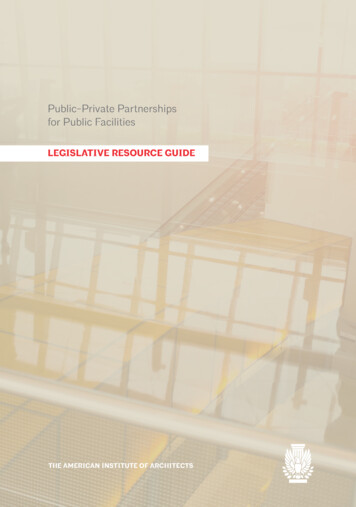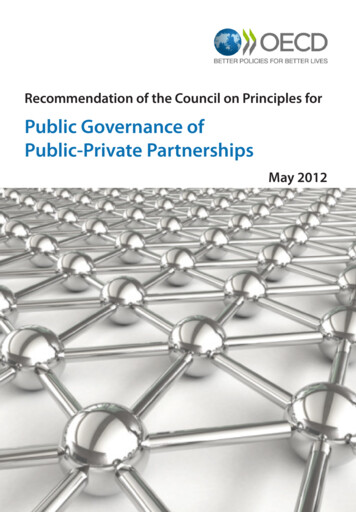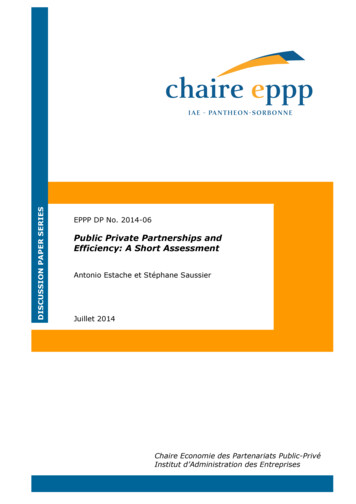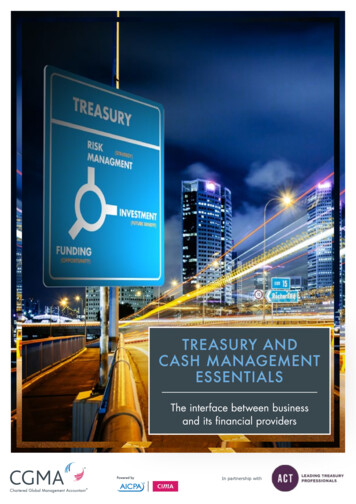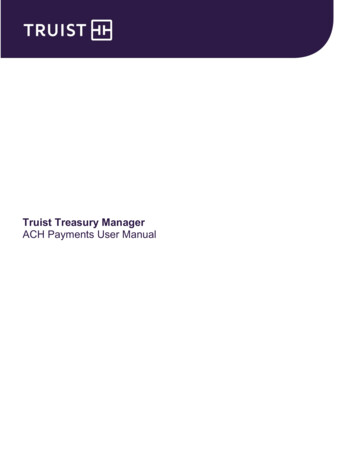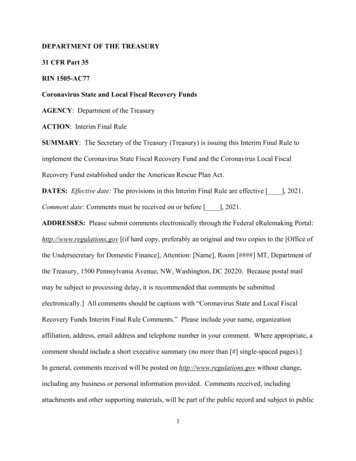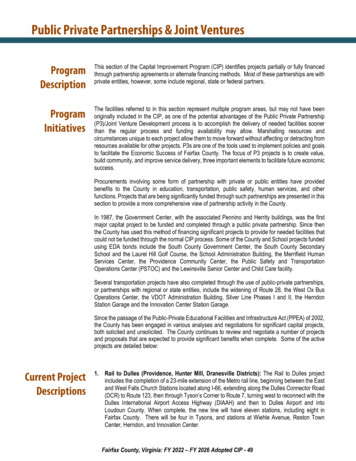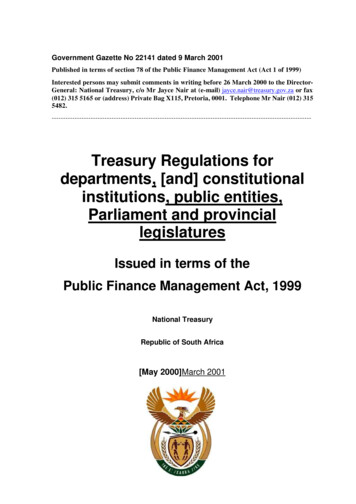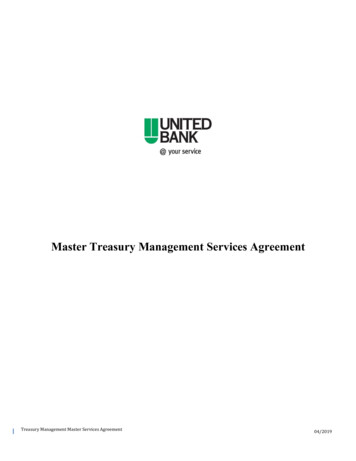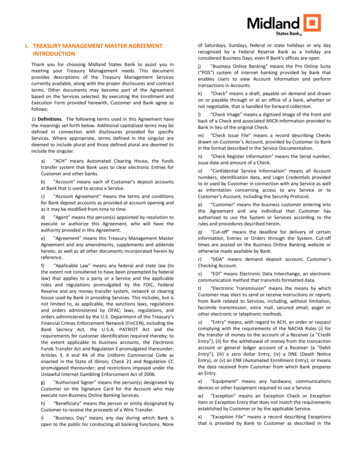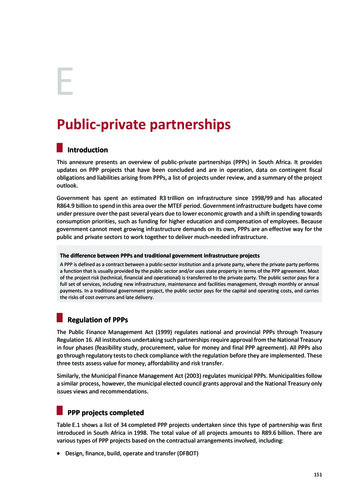
Transcription
EPublic-private partnershipsIntroductionThis annexure presents an overview of public-private partnerships (PPPs) in South Africa. It providesupdates on PPP projects that have been concluded and are in operation, data on contingent fiscalobligations and liabilities arising from PPPs, a list of projects under review, and a summary of the projectoutlook.Government has spent an estimated R3 trillion on infrastructure since 1998/99 and has allocatedR864.9 billion to spend in this area over the MTEF period. Government infrastructure budgets have comeunder pressure over the past several years due to lower economic growth and a shift in spending towardsconsumption priorities, such as funding for higher education and compensation of employees. Becausegovernment cannot meet growing infrastructure demands on its own, PPPs are an effective way for thepublic and private sectors to work together to deliver much-needed infrastructure.The difference between PPPs and traditional government infrastructure projectsA PPP is defined as a contract between a public-sector institution and a private party, where the private party performsa function that is usually provided by the public sector and/or uses state property in terms of the PPP agreement. Mostof the project risk (technical, financial and operational) is transferred to the private party. The public sector pays for afull set of services, including new infrastructure, maintenance and facilities management, through monthly or annualpayments. In a traditional government project, the public sector pays for the capital and operating costs, and carriesthe risks of cost overruns and late delivery.Regulation of PPPsThe Public Finance Management Act (1999) regulates national and provincial PPPs through TreasuryRegulation 16. All institutions undertaking such partnerships require approval from the National Treasuryin four phases (feasibility study, procurement, value for money and final PPP agreement). All PPPs alsogo through regulatory tests to check compliance with the regulation before they are implemented. Thesethree tests assess value for money, affordability and risk transfer.Similarly, the Municipal Finance Management Act (2003) regulates municipal PPPs. Municipalities followa similar process, however, the municipal elected council grants approval and the National Treasury onlyissues views and recommendations.PPP projects completedTable E.1 shows a list of 34 completed PPP projects undertaken since this type of partnership was firstintroduced in South Africa in 1998. The total value of all projects amounts to R89.6 billion. There arevarious types of PPP projects based on the contractual arrangements involved, including: Design, finance, build, operate and transfer (DFBOT)151
2019 BUDGET REVIEW Design, finance and operate (DFO)Design, build, operate and transfer (DBOT)Equity partnershipsFacilities management projects.Of the 34 PPP projects, 26 are DFBOT projects, four are DFOs, two are DBOTs, one is an equity partnershipand one is a facilities management project. They include hospitals, transport and roads, tourism, andhead office accommodation projects. The projects have been funded through a combination of equity,debt and, in some instances, government capital contributions. Most of these projects are alreadyoperational, with a few having reached the end of their project term. In some instances, project durationshave been extended.Table E.1 List of PPP projects completedProject nameGovernment institutionTypeDate ofDuration1closeTransportSANRAL N4 Ea s t Tol l Roa dSANRALDFBOTFeb-199830 yea rsSANRAL N3 Tol l Roa dSANRALDFBOTNov-199930 yea rsSANRAL N4 Wes t Toll RoadSANRALDFBOTAug-200130 yea rsNorthern Ca pe fl eetNorthern Ca peDepa rtment of Trans port,Roads and Publ i c WorksWes tern Ca pe Depa rtmentof Tra ns port a nd Publ icWorksEa s tern Ca pe Depa rtmentof Tra ns portDepa rtment of Trans portCi ty of Ts hwaneGa uteng Depa rtment ofPubl i c Tra ns port, Roa dsa nd WorksSANRALDFONov-20015 yea rsDFBOTMay-200330 yea rsDFOAug-20035 yea rsDFODFODFBOTSep-2006Nov-2015Sep-20065 yea rs5 yea rs20 yea rsDFBOTOct-200720 yea rsKwa-Dukuza LocalMuni ci pa l i tyDFBOTJan-199930 yea rsMbombel a Loca lMuni ci pa l i tyDFBOTDec-199930 yea rsDFBOTAug-200030 yea rsDFBOTDec-200115 yea rsDFBOTNov-2002Cha pma n’s Peak Dri ve Tol l Roa dFl eet ma nagementNa ti ona l fleet ma nagement Ts hwane fl eet ma nagementGa utra i n Ra pi d Ra i l Li nkSANRAL Gauteng Freewa yImprovement Pla n Tol l Roa dWater and sanitationDol phi n Coa s t wa ter a nds a ni tati on conces s i onMbombel a wa ter a nd s a ni ta tionconces s i onCorrectional servicesMa nga ung a nd Ma kha do ma xi mum Depa rtment ofs ecurity pri s onsCorrecti ona l ServicesHealthInkos i Al bert Luthul i Hos pi ta lKwaZul u-Na ta lDepa rtment of Hea l thUni vers i tas a nd Pel onomiHos pita l s co-l oca ti onFree State Depa rtment ofHeal thSta te Va ccine Ins ti tuteDepa rtment of Hea l thHumans dorp Dis tri ct Hos pi ta lPha l aborwa Hos pi talWes tern Cape Reha bi l i tati onCentre a nd Lentegeur Hos pi talEquitypa rtners hi pEa s tern Ca pe Depa rtment DFBOTof Hea l thLi mpopo Depa rtment ofDFBOTHeal th and Soci alWes tern Ca pe Depa rtment Fa cil i ti esof Hea l thma na gementPol okwa ne Hos pi ta l renal di al ys i s Li mpopo Depa rtment ofDBOTHeal th and Soci alPort Al fred a nd Settlers Hos pita lEa s tern Ca pe Depa rtment DFBOTof Hea l th152FinancingstructureDebt: 80%Equi ty: 20%Debt: 80%Equi ty: 20%Debt: 80%Equi ty: 20%Equi ty: 100%Debt: 44%Equi ty: 10%Govt: 46%Debt: 100%Equi ty: 100%Equi ty: 100%Debt 11%Equi ty: 2%Govt: 87%Debt: 100%Project valueR millionForm of payment3 200Us er cha rges3 000Us er cha rges3 200Us er cha rges181Uni ta ry pa yment450Us er cha rges a ndguara ntee553Uni ta ry pa yment9191 61231 80020 000Servi ce feeServi ce feeUs er cha rges a ndpatronageguara nteeUs er cha rgesDebt: 21%Equi ty: 18%Govt: 61%Debt: 40%Equi ty: 31%Govt: 29%130Us er cha rges189Us er cha rgesDebt: 88%Equi ty: 12%3 600Uni ta ry pa yment4 500Uni ta ry pa ymentDebt: 70%Equi ty: 20%Govt: 10%16.5 yea rs Equi ty: 100%81Us er cha rgesApr-20034 yea rsEqui ty: 100%75Jun-200320 yea rsEqui ty: 90%Govt: 10%49Once-off equi tycontri buti onUni ta ry pa ymentJul -200515 yea rsEqui ty: 100%90Us er cha rgesNov-200612 yea rsEqui ty: 100%334Uni ta ry pa ymentDec-200610 yea rsEqui ty: 100%88Uni ta ry pa ymentMay-200717 yea rsDebt: 90%Equi ty: 10%169Uni ta ry pa yment
ANNEXURE E: PUBLIC-PRIVATE PARTNERSHIPSTable E.1 List of PPP projects completed (continued)TourismSANPARKS touri s m projectsSANPARKSDFBOTApr-2000Li mpopo Department ofDFBOTFi nance, Economi c Affa i rs ,Touri s mCra dl e of Huma nki ndGa uteng Department ofDBOTInterpreta tionAgri cul ture, Cons erva ti on,Centre Compl exEnvi ronment and LandAffa irsWes tern Cape Na ture Cons ervati on Wes tern Ca pe Provinci a lDFBOTBoa rdGovernmentInformation technologyInforma ti on s ys temsSoci a l gra nt pa yment s ys temEco-touri s m Ma nyel eti three s itesOffice accommodationHea d offi ce a ccommoda ti onHea d offi ce a ccommoda ti onHea d offi ce a ccommoda ti onEqui ty: 100%270Us er cha rgesDec-2001Vari ousyea rs30 yea rsEqui ty: 100%25Us er cha rgesOct-200310 yea rs39Us er cha rgesJul -200530 yea rsEqui ty: 100%opexGovt: 100%capexEqui ty: 100%40Us er cha rges1 500260Uni ta ry pa ymentUni ta ry pa yment870Uni ta ry pa yment1 959Uni ta ry pa yment512Uni ta ry pa yment2 731Uni ta ry pa yment2 533Uni ta ry pa yment2 005Uni ta ry pa ymentDepartment of La bourFree Sta te Depa rtment ofSoci al Devel opmentDFBOTDFODec-2002Apr-200410 yea rs3 yea rsEqui ty: 100%Equi ty: 100%Department of Tra dea nd Indus tryDFBOTAug-200325 yea rsDepartment ofInterna ti ona l Rel a ti onsDepartment of Educa ti onDFBOTJa n-200525 yea rsDFBOTAug-200927 yea rsDebt: 80%Equi ty: 8%Govt: 12%Debt: 81%Equi ty: 19%Debt: 90%Equi ty: 10%Debt 49%Equi ty: 15%Govt: 36%Debt 54%Equi ty: 9%Govt: 37%Debt: 86%Equi ty: 14%Hea d offi ce a ccommoda ti onDepartment ofEnvi ronmenta l Affai rsDFBOTMa y-201225 yea rsHea d offi ce a ccommoda ti onSta tis ti cs South AfricaDFBOTMa r-201424 yea rsHea d offi ce a ccommoda ti onCi ty of Ts hwa neDFBOTMa r-201525 yea rs3 991Debt: 54%Equi ty: 10%Govt: 36%1. Refers to a phase in which all contract conditions of the financing established between government, private party and lenders is finally closedSource: National TreasuryHea d offi ce a ccommoda ti onDepartment of RuralDevel opmentDFBOTFeb-201927 yea rsUni ta ry pa ymentNote – Govt: government; Capex: capital expenditure; Opex: operational expenditure; Dept: department; Unitary payments: government payments forinfrastructure and related servicesOf the R864.9 billion planned for public-sector infrastructure spending over the next three years (seeAnnexure D), PPP projects account for R17.3 billion, or 2 per cent of the total public-sector infrastructurebudget estimate. Table E.2 shows the unitary payments (government payments for infrastructure andrelated services) for PPP projects operating over the medium term by sector.Table E.2 Estimated unitary payments of PPPs in operation over the MTEF period by sectorR millionTra ns portAccommoda ti onHea l thCorrecti ona l s ervi ces fa ci l i ti esTotalSource: National Treasury2018/192 2751 5281 0161 0945 9122019/202 3871 6141 0691 0446 1142020/212 5171 6921751 0745 4592021/222 6561 7851851 1335 759MTEF7 5605 0921 4303 25017 332Most of the PPPs under way are transport and accommodation projects, with a few in the health andcorrectional services sectors. Municipal solid waste, transport and accommodation projects are startingto play a larger role in PPPs and this trend is expected to continue over the next three years.PPP contingent liabilitiesPPP contingent liabilities arise only where a contract is terminated. PPP projects involving public-sectorunitary payments have contingent fiscal obligations to compensate the private sector if the contract isterminated before its expiry date. PPP agreements can also impose other fiscal obligations ongovernment that are not defined as contingent liabilities. For example, where the private sector collectsuser charges from the public, government usually guarantees a minimum revenue stream, which imposes153
2019 BUDGET REVIEWa fiscal obligation and requires appropriate budget allocations. The National Treasury’s four-stageapproval process (discussed above) allows it to ensure that the contingent liabilities in contracts areacceptable.There are various categories of contingent liabilities, depending on whether the termination is the resultof private-sector default, government default or force majeure – an event beyond either party’s control.Compensation depends on the reason the contract ended, but termination as a result of governmentdefault usually results in the greatest compensation. Table E.3 shows potential termination amounts persphere of government.Table E.3 Level of potential government contribution to contingent liabilities by categoryTermination privateTermination forceTerminationparty defaultmajeuregovernment default2017/182018/192017/182018/192017/182018/19R millionNa ti ona l depa rtments expos ure3 070.53 464.62 777.93 655.94 687.65 348.0Provi nci a l depa rtments expos ure3 803.24 892.53 571.32 591.32 372.84 742.3557.0489.2555.7414.8767.0614.4Publ i c enti ti es expos ure12 675.92 274.52 269.11 928.83 360.92 856.7Muni ci pa l expos ureTotal10 106.59 799.68 194.08 372.3 13 708.0 13 561.41. Municipalities are an autonomous sphere of government and therefore their liabilities are not part of the fiscusSource: National TreasuryContingent liabilities for PPPs as a result of contracts terminating due to government default amountedto R13.6 billion in 2018/19 – decreasing from R13.7 billion in 2017/18. This slight decrease was expectedas government continues to pay off debt and equity owed to the private sector. It has also been offsetby the inclusion of the recently concluded rural development PPP.Of the three spheres of government, national departments account for the greatest exposure, amountingto R5.3 billion in 2018/19. Head office accommodation projects and the Gautrain Rapid Rail Link projectare the biggest contributors to government’s exposure to contingent liabilities.Government manages the risk emanating from PPP contingent liabilities by closely monitoring eachparty’s performance against their contractual obligations and enforcing tight regulatory requirements.PPP projects under reviewTable E.4 provides a pipeline of PPP projects under review. These include extending the Gautrain rapidrail network, redeveloping six border posts, constructing the Kopanong precinct and building new schoolsfor the Gauteng Schools Programme. These projects will be subject to the necessary approvals beforethey are implemented.154
ANNEXURE E: PUBLIC-PRIVATE PARTNERSHIPSTable E.4 Pipeline of PPP projects under reviewProject nameTransportExtens ion of the Ga utra i n Ra pidRa il LinkGa utra in: Acquis iti on ofa ddi ti ona l rol l i ng s tockImplementingagentProject descriptionGa uteng Depa rtment ofRoa ds a nd Tra ns portGa uteng Depa rtment ofRoa ds a nd Tra ns portExpa ns ion of the exi s ting Ga utra i n ra i lnetworkProcurement of 48 a dditi ona l coa chesa nd expa ns i on of depot fa ci li ty toa ccommoda te increa s ed dema ndDe Aa r Logis ti cs HubNorthern Ca pe Depa rtment Provi s i on of a s us ta i na ble tra ns portof Tra ns port, Sa fety a ndnetwork for the tra ns porta ti on ofLi a i s onfreight/products by s ma l l mi ners a ndfa rmersBorder pos tsDepa rtment of Home Affa irs Redevel opment of 6 border pos tsProcurement of emergency towing Depa rtment of Tra ns portProcurement of 2 emergency towing ocea nvehi clesves s el sHealthTri -genera tion Chri s Ha niGa uteng Depa rtment ofIns ta l l a tion of tri-genera ti on pl a nts a tBa ra gwa na nth Hos pita lInfra s tructure Devel opment the Chris Ha ni Ba ra gwa na nth Hos pi ta l toreduce dependence on the na ti ona l gri dWes tern Ca pe Depa rtment Development of Tygerberg Hos pita l a ndTygerberg Hos pi ta lof Hea lthequi pment provi s i onEnergyGa uteng Depa rtment ofIns ta l l a tion of s ol a r pa nels on Ga utengRooftop s ola r projectInfra s tructure Devel opment provi nci a l government bui ldingsOffice accommodationKopa nong PrecinctGa uteng Depa rtment ofCons tructi on of Ga uteng provi ncia lInfra s tructure Devel opment government offi ce to cons ol ida tea dminis tra ti on function of 19 buil di ngs inthe Joha nnes burg CBDKwa Zulu-Na ta l GovernmentKwa Zulu-Na ta l Depa rtment Cons tructi on of a n offi ce preci nct for KZNPreci nctof Publi c Worksprovi nci a l depa rtments inPieterma ri tzburgBhis ho Office Preci nctEa s tern Ca pe Depa rtment of Cons tructi on of offices for 7 Ea s tern Ca peRoa ds a nd Publ i c Worksdepa rtments i n a s i ngle l oca ti on i nBhis hoInnova ti on HubGa uteng Depa rtment ofDevelopment of a s cience pa rk whereEconomi c Devel opmententrepreneurs wil l network a nd excha ngei dea sEkurhuleni Preci nctEkurhul eni MetroCons ol ida tion of the muni ci pa l i ty’sMunicipa l ityva rious s ervi ce-deli very depa rtments intoa centra l is ed munici pa l offi ceNew muni cipa l office projectBi tou Loca l Munici pa l ityCons ol ida ti on of the muni ci pa l i ty’sva rious s ervi ce-deli very depa rtments intoa centra l is ed munici pa l offi ceDepa rtment of Sci ence a nd Des i gn a nd cons tructi on of new bui l dingHea d office a ccommoda ti onTechnol ogya nd refurbis hment of a n exi s ting buil di ngSolid wasteKwa Dukuza wa s te s ervi cesKwa Dukuza Loca lColl ection a nd dis pos a l of s ol id wa s teMunicipa l ityfrom hous ehol dsSol id wa s te di vers ion a ndbenefi ci a ti on opportuni ti esNels on Ma ndel a Ba yMunicipa l ityMos s el Ba y regi ona l l a ndfi l lfa cil i tyEden Di s trict Muni ci pa l i tyDevelopment of wa s te ma na gementi nfra s tructure to trea t wa s te forbenefi ci a l reus e or s a leDevelopment of a s ol i d wa s te a ndl a ndfi l lCurrent statusFeas ibil ityFeas ibil ityFeas ibil ityFea s ibil ityFeas ibil ityProcurementFeas ibil ityProcurementFeas ibil ityProcurementProcurementProcurementFeas ibil ityProcurementFeas ibil ityProcurementProcurementProcurementWater and sanitationPol okwa ne s a ni ta tion projectUmhla thuze wa s tewa ter s ervi cesEducationGa uteng s chools progra mmeIkus a s aPolokwa ne munici pa l ityUmhla thuze muni ci pa li tyIncrea s e wa s tewa ter trea tment ca pa cityDevelopment of a regi ona l wa s te-wa tertrea tment pl a nt for i ndus tri a l cus tomersFea s ibil ityFeas ibil ityGa uteng Provi ncia lGovernmentDepa rtment of Hi gherEduca tionDes i gn a nd cons tructi on of new s choolsFea s ibil ityStudent Fi na nci a l Ai d Progra mmeFea s ibil itySource: National Treasury155
2019 BUDGET REVIEWPPP project outlookSouth Africa has established a flow of successful PPPs over the last decade. The country has a strong,transparent regulatory framework that manages risk and provides returns for private investors.Nonetheless, a number of challenges have arisen over the years, leading to project delays andcancellations in some cases. The number of new PPP transactions has declined from an estimatedR10.7 billion in 2011/12 to R4.8 billion in 2017/18.The National Treasury, together with the PPP unit in the Government Technical Advisory Centre (GTAC)has initiated a review of the PPP framework to address these challenges. The review will consider theexperiences of other countries and lessons learnt from the PPP framework over the years, andrecommend changes to the PPP framework to improve its effectiveness. As part of the review, thefollowing initiatives are being considered: Merging some of the approval requirements. Developing a framework for soft PPPs (these projects relate to the provision of “soft” infrastructurefacilities and related non-core services). Introducing partnerships that will allow public entities to work with other public-sector organisationson infrastructure projects. This approach is used in many other countries. Reviewing the PPP legislative framework. Putting in place mechanisms to address the affordability gap in PPPs.In 2018, the President announced an Infrastructure Fund initiative that builds on efforts to transformpublic infrastructure provision. The initiative encourages the public sector to work with the private sectorin the planning and implementation of infrastructure projects. Over the medium term, the initiative willfocus on developing PPP projects in priority areas that have the potential to crowd-in private sectorfunding, that can contribute to economic development and that are in line with the country’s strategicplanning documents.More information on PPPs and the Infrastructure Fund is available on the websites of GTAC and theDevelopment Bank of Southern Africa.156
Public-private partnerships Introduction This annexure presents an overview of public-private partnerships (PPPs) in South Africa. It provides updates on PPP projects that have been concluded and are in operation, data on contingent fiscal obligations and liabilities arising from PPPs, a list of projects under review, and a summary of the project
